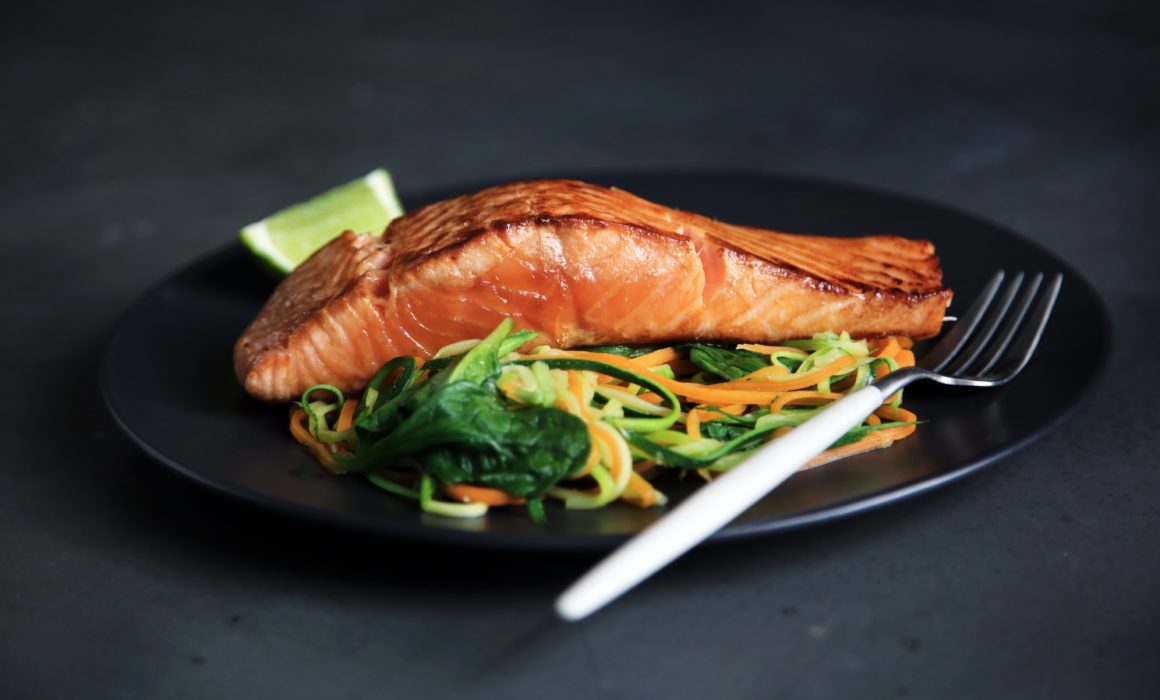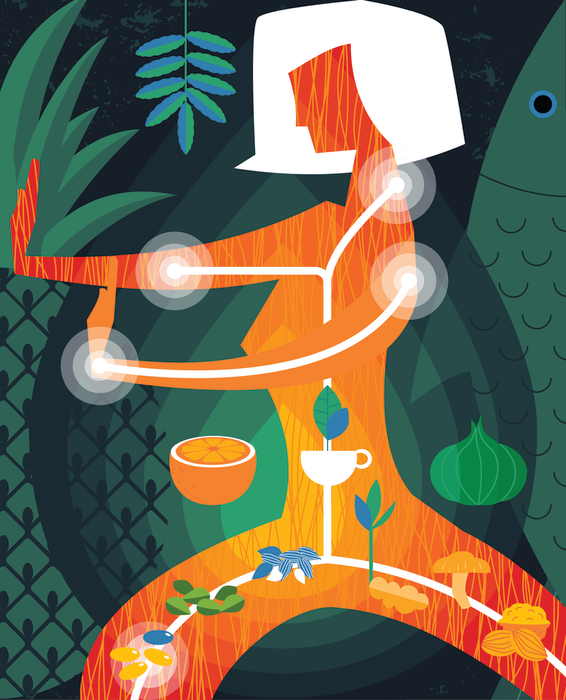What do cancer, cardiovascular disease, autoimmune disease, and all chronic degenerative diseases have in common? Inflammation.
Most people associate inflammation with injuries that they can see, such as a twisted ankle, scraped knee, or a bee sting. These are all examples of obvious inflammation, easily identified with the naked eye, which occur as part of the healing process in response to an acute injury.
However, it is the inflammation we can’t see – the subtle low-grade chronic inflammation that happens at a cellular level – that can eventually overwhelm our pre-set defences, resulting in tissue damage and degeneration associated with chronic disease.
So what causes inflammation and how can we adjust our diet and lifestyle to avoid the ultimate consequences of uncontrolled inflammation?
Inflammation is at the root of so many diseases it is impossible to estimate the physical and economic impact it has on the Australian population. For example, two common conditions that have their foundations firmly planted in chronic inflammation are cancer and cardiovascular disease.
These two conditions alone are estimated to make up approximately 37 percent of the total disease and injury burden in Australia. This is just the tip of the iceberg; then there are autoimmune diseases, arthritis, allergies, neurodegenerative conditions, obesity and even depression which are also associated with inflammation, making it the leading cause of ill health.
What is inflammation?
The term inflammation comes from the Latin inflammo, which means ‘to ignite’. The process of inflammation was described in detail in one of the oldest recorded medical and scientific texts, De Medicia, written by the Roman scholar Aulus Cornelius Celsus (c. 25BC-c.50AD).
He described the various stages of inflammation as follows: dolor (“pain”), calor (“heat”), rubor (“redness”), and tumor (“swelling”). Later scholars added a final term, ‘functio laesa’, which translates to loss of function.
These observations still stand the test of time, however we now have a greater understanding of the cellular mechanisms involved.
Inflammation is the body’s first line of defence. When the body senses that there is an injury, a complex cascade of chemical messengers is released which triggers an immediate inflammatory response in order to neutralise, or ‘burn out’, any bacteria or pathogens present and flood the affected site with cells that will initiate the healing process.
Inflammation is part of our innate immunity, which means it is an inbuilt protective mechanism we were born with. It is not specific to any particular pathogen or bacteria, but more of a generalised protective response. The immune system cells are first on the scene and act as the foreman of the healing process, neutralising any existing threats and overseeing repair work. This is how the body should respond to any acute injury.
However, what happens when the threat is continual and the immune system is perpetually activated causing widespread, low-grade inflammation? This is where things go wrong and tissue degeneration and damage occur.
Cancer
Uncontrolled inflammation caused by chronic infection or irritation is well-recognised as a cause of cancer. For example, Helicobacter pylori, a common bacterial infection of the stomach, is also associated with gastric cancer, while viral hepatitis C is associated with the development of liver cancer. The chemicals in cigarette smoke lead to significant tissue irritation and inflammation, which ultimately causes cancer.
Chronic inflammation eventually damages the DNA of cells, and once rogue cells are established they are able to replicate themselves to the point that they create microscopic tumours. These tumours can then further harness the inflammatory process, using it to create new blood vessels which deliver nutrients and oxygen to fuel greater growth and replication.
Preventing cancer by managing inflammation has attracted significant attention from the scientific community. Several large trials, involving a total of 23,000 people, investigated the ability of aspirin (a common anti-inflammatory drug) to prevent strokes and heart attacks. Interestingly, data also examined the development of cancer in the trial participants and – astoundingly – there was a 34 percent reduction in all cancers and a 54 percent reduction in gastrointestinal cancers specifically.
Despite these amazing results, even the Cancer Council of Australia agrees, taking aspirin is not an ideal solution. Managing inflammation naturally through diet, lifestyle and nutritional supplementation is the best way to reduce inflammation and overall cancer risk.
Cardiovascular disease
Sadly, cardiovascular disease kills one person every 12 minutes in Australia and despite the advances in medical treatment it remains the leading cause of death. Inflammation influences every aspect of cardiovascular disease, not only in the initiation of vascular disease but also the triggering of clot formation.
The delicate cells lining the blood vessel walls are easily damaged by oxidative stress. As part of the healing process, a complex interaction between inflammation and small dense cholesterol molecules occurs at the site, which causes microscopic scarring and plaque formation. If this process continues unchecked, atherosclerosis develops and it is only a matter of time before a cardiovascular event, such as a heart attack, happens.
Smoking is a well-known cause of atherosclerosis, which is at least partly due to its ability to trigger widespread oxidative stress and inflammation.
Studies show that while aspirin may be useful for the prevention of stroke in women, its efficacy in preventing heart attack is still not proven and the Australian Heart Foundation recommends that lifestyle measures should be the main aim of preventative treatment.
Autoimmune diseases
There is a wide variety of autoimmune diseases, ranging from multiple sclerosis to coeliac disease, all of which have inflammation as a primary driver. These diverse conditions are caused by the immune system mistaking our own tissue for a foreign invader and launching an inflammatory attack to neutralise the ‘threat’.
While the exact cause of autoimmune disease is unknown, several contributing factors have been identified.
Chronic bacterial or viral infection may play a role based on the concept of ‘molecular mimicry’, where specific proteins of some pathogens are so similar to our own that the immune system becomes confused and starts to attack our own tissue.
Another theory is the complex interaction between the bacteria in the digestive tract (called the gut microbiome) and its interaction with the immune system. The modern diet can significantly disrupt the microbiome and cause inflammation of the gut lining. This damages the delicate pores in the gut lining and leads to the absorption of irritant substances, including bacterial by-products, from inside the gut into the circulation where the immune system reads it as a foreign invader. The subsequent inflammatory reaction launched by the immune system can cause significant damage.
Obesity
This may not be the first condition that springs to mind when we think about inflammation, but mounting evidence suggests that obesity, insulin resistance, and even type II diabetes may be related to inflammation.
Obesity is at epidemic proportions in Australia, with three out of five adults being overweight or obese. Even more worrying is that one out of every four children is overweight or obese, setting up our next generation for a life of ill health. According to the Australian government, these figures have risen by five percent since 1995 and show no signs of slowing.
While we know that the modern diet is fundamentally at the heart of the obesity epidemic, what we may not have considered is its effect on inflammation. The modern Western diet is based on processed foods that are high in refined carbohydrates, sugars and fats and flooded with chemical additives.
While the refined foods cause us to gain body fat (which in itself is inflammatory) the numerous chemical additives contribute to the systemic inflammation.
Insulin receptor sites on the cell wall are easily damaged by inflammation, which is thought to contribute to insulin resistance. Further to this is the effect of a highly processed diet on the gut microbiome causing inflammation.
So it seems it is a double-edged sword: once obesity is established, inflammation can perpetuate it, contributing to significant metabolic disruption.
Depression
This is a newcomer to the group of diseases driven by inflammation; however, emerging evidence is offering new insights into a complex condition that affects approximately 45 percent of Australians at some stage in their life.
A recent study has identified significant inflammation in the brains of depressed patients, using sophisticated PET scanning technology. They found that people with depression had a 30 percent increase in inflammation compared to healthy controls; they also found that the worse the depression, the greater the inflammation.
While this area of study is in its infancy, it offers some hope to people looking for answers.
What you can do to reduce inflammation
Diet
The typical Australian diet is very inflammatory, due to high intake of processed foods, refined carbohydrates, sugar, salt and fat, not to mention chemical additives and pesticides and herbicides used in farming. Even some of the ‘healthy’ choices found on our supermarket shelves can fit into this category.
The best way to ensure that you have an anti-inflammatory diet is to avoid the supermarket and buy most of your food fresh from the greengrocer, fishmonger, and local butcher.
A wholefood diet is arguably the single most effective step you can take to reduce inflammation. Not only is it high in valuable nutrients and low in irritating chemicals and additives, it also provides your body with the building blocks to fuel balanced immune responses, robust gut microbiome function, and effective elimination of toxins via healthy liver and gut function, all of which will help manage inflammation.
Vitamin D
This is a fat-soluble nutrient that helps us maintain bone strength and immune system health. Recently it has been shown to directly interact with the genes associated with inflammation and act as a powerful anti-inflammatory and pain reliever. Small amounts of vitamin D are found in fish, eggs and dairy.
Bioflavonoids
Vegetables are rich in a range of flavonoids that have significant anti-inflammatory effects. This group includes the powerful antioxidants found in berries and green tea, along with quercetin, rutin, and hesperidin, found in citrus fruit. A diet high in plant food should provide a wide range of flavonoids that will minimise inflammation; supplementing with bioflavonoids can also help.
Fish oil
Eicosapentaenoic acid (EPA), found in fish oil, acts to directly inhibit platelet aggregation and down-regulate the inflammatory cascade. Taking a high quality fish oil supplement daily can significantly reduce inflammation.
Turmeric
This is a potent anti-inflammatory herb which has been traditionally used to treat inflammatory conditions. Numerous studies and clinical trials have demonstrated that its active constituent, curcumin, is effective in both acute and chronic inflammation.
Boswellia
Found to reduce pain and inflammation in clinical trials, boswellia acts to significantly reduce inflammation without irritating the gut like pharmaceutical anti-inflammatories. Often included in formulas to treat arthritis.
Cat’s claw
A Peruvian vine traditionally used to treat arthritis and stomach complaints, cat’s claw has significant anti-inflammatory and pain-relieving properties.
Do’s and Don’ts
DO
- Eat vegetables. Aim to have between six to nine serves of vegetables per day, buy organic where you can or soak and scrub them if they’re not.
- Eat fruit. Enjoy a couple of pieces of fruit per day.
- Eat deep-sea, oily fish such as wild-caught salmon, sardines or mackerel, at least three times per week.
- Eat nuts and seeds – enjoy a handful a day.
- Eat poultry. Choose organic, free-range poultry products.
- Eat grass-fed, organic red meat sparingly – no more than a couple of times per week.
- Eat whole grains. Choose small to moderate amounts of quinoa, buckwheat, amaranth, rice.
- Drink alcohol. Save it for special occasions only, as it’s very inflammatory.
- Eat gluten. This is considered an inflammatory component of grains like wheat, barley and rye.
- Eat too much sugar. It’s in nearly all processed foods, and nearly impossible to avoid if buying packaged foods.
- Eat trans fats, which are found in fried food, potato crisps, margarine, bakery items, biscuits and many tinned and packaged foods.
- Eat refined carbohydrates – this includes bread, biscuits, pastries and crackers.
- Eat food additives. The range is endless, as they are found in almost all packaged and tinned foods.
Top 10 anti-inflammatory foods
- Pineapple
- Cherries
- Ginger
- Oily fish
- Blueberries
- Green tea
- Garlic
- Shiitake mushrooms
- Papaya
- Broccoli
If you suffer from inflammation or would like to reduce your risk of chronic disease see your health care practitioner today.
This article first appeared in Nature & Health magazine.
Download the article



